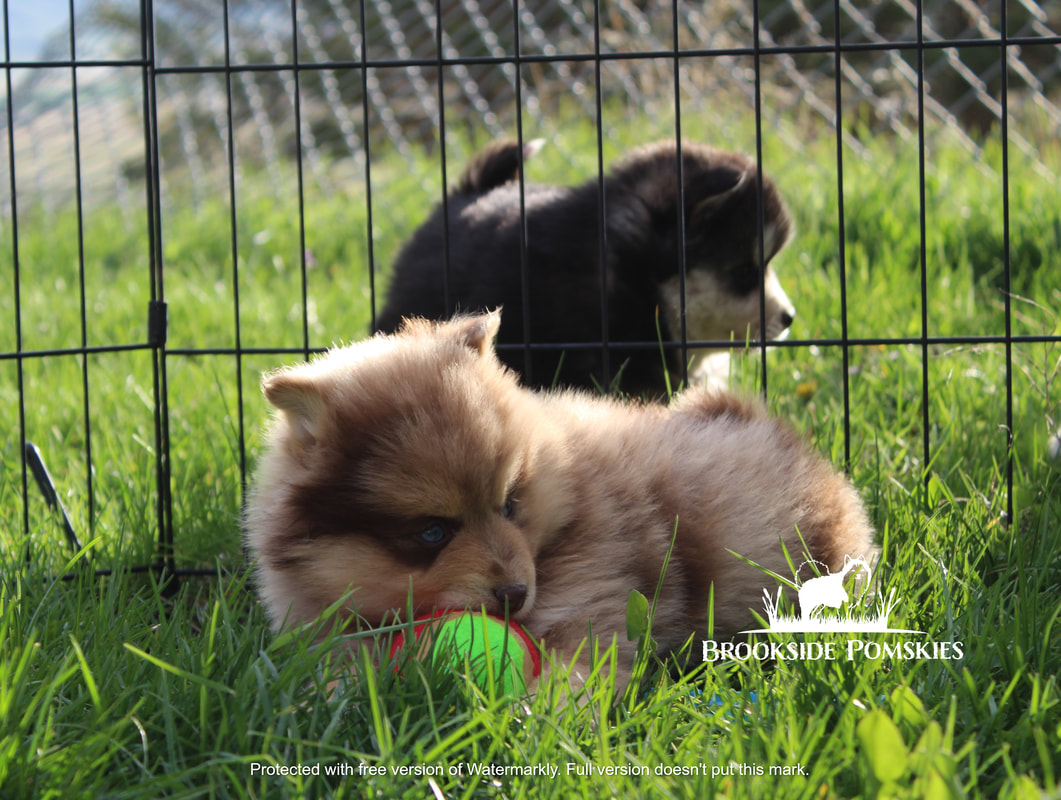|
Part One of this This article was written by Jake at Pomsky Owners Association
Welcome to part two of our pomsky training mini-series. In this mini-series, we’re giving you bits and pieces from our Pomsky Training Book to help you train the perfect pomsky. Pomsky training tips These are must read tips BEFORE you begin training. Five pomsky training tips:
Start Young Start training as soon as your pomsky comes home. The younger your pomsky is the easier it will be to train. Your pomsky needs to know at a young age that the owner is the one that provides value. When the pomsky behaves, the owner is the one that provides praise, the owner gives treats and the owner decides when the pomsky can play. Remember to start with the basics. Get the basic behavioral training and commands down first; these are absolutely the most important aspect of a well-behaved pomsky, don’t get too excited about teaching your pomsky party tricks. Even though they may be boring they are crucial to the harder commands. Don’t expect your dog to learn 5 new commands in one day. Understanding that the process is slow is important. Training cannot be rushed. Training a pomsky is a lifelong task. It’s important to start small and work your way up. Start with the priorities such as recall, sit, stay, where to potty, when to eat and not to beg. Once you master the simple commands and behaviors, it will be much easier to move onto the complex tricks and advanced commands. Use Treats Treats are an effective method of keeping your Pomsky’s attention. Think of treats as a training tool, not a bribe. Use treats to your advantage and teach your pomsky early that they will be rewarded for behaving. Most Pomskies are highly food motivated. Use that to your advantage when training and trying to keep their attention. We highly recommend using treats to train your pomsky. Keep Sessions Short Short training sessions always work best. Training is mentally stimulating, you don’t want your pomsky to tire and become frustrated with the training. Keep your training session short, no longer than 10 to 15 minutes a couple times per day. Any longer than 15 minutes and you run the risk of doing more damage than good, you’ll lose your pomskies attention and you’ll end up teaching the pomsky to be distracted rather than engaged. Here at Brookside Pomsky we train ours for approximately 10 min sessions twice a day and have great results. This does not include the time it takes to potty train, crate train, and exercising the puppy. Be Consistent Consistency is key. Pomsky breeders agree that lack of consistency is the number one biggest reason that pomsky owners fail to train their pomskies. Consistency means you start training and stick to it. You should be consistent in all of the following:
We will discuss this more in part 3 of the pomsky training series where we break down exactly how to keep consistent with your pomsky training efforts. Buy Now on Amazon – Pomsky Training and Owners Guide Teach Engagement Engagement means having your pomskies complete attention. Whether you are training, giving a command or playing with your pomsky, engagement means your pomsky is completely and totally focused on you. One way to get your pomsky completely engaged is for him to get his energy out before training sessions begin. If he's too active or excited, he won't listen. Go on a quick run or walk before your training session begins. A pomsky that is engaged wants to be with you and wants what you have, whether you have a favorite toy or a treat, the pomsky is fully focused on you and only you. An engaged pomsky is more interested in you than anything else in the world. Without engagement it’s impossible to even begin training your pomsky; if your pomsky is not engaged they will not learn, they will never be fully trained, and the future behavior of the pomsky will be jeopardized. If you don’t have your dog’s eyes, you don’t have your dog. Some pomsky owners refer to this as “respect” because a disengaged pomsky appears disrespectful, ignoring your commands and disregarding you in general. This is a common misconception. Your pomsky is not disrespecting you; it’s just not engaged with you. Your Pomsky has learned that other things are more interesting than what you have to offer. Engagement must be taught before any other training. Pomskies that learn engagement as their first behavior become much easier to train; it creates a positive attitude towards learning and training and creates a stronger bond between the Pomsky and owner. Here is one way to teach your pomsky engagement. In this process, we’re teaching the them that in return for engagement, they will be rewarded with a treat:
Download Now – Pomsky Training and Owners Guide Next Steps Now that you’ve read through the Pomsky training tips you should begin teaching your Pomsky engagement, use the step by step instructions provided above to begin training your Pomsky. If you need more insight, examples, and step by step instructions on how to train your pomsky check out our Pomsky Training Book. Once you teach engagement, move onto the next part of our Pomsky training mini-series:
Here’s a summary of the top five training tips from pomsky breeders:
This article was intended to help you get a better understanding of how to better train your Pomsky with 5 easy to follow steps. If you are interested in adding a Pomsky to your family, Brookside Pomskies is the place to go! We have a variety of available pomskies for you to choose from, you can check out our Pomsky Puppies for sale or fill out an application. Congratulations on your journey of becoming a fantastic dog owner.
0 Comments
Pomskies are great dogs by nature, but when they whine, it’s hard to know what to do. That’s where we come in. Training your Pomsky to stop barking and whining is easier than you think as long as you have patience and are willing to show lots of love and affection when getting there. In this article, we are going to tell you the top 5 things you can do to get your Pomsky to quiet down and whine less often. Before we get started, it is always wise to know that if your Pomsky has just started to whine and it is very uncommon for them there may be a medical concern and you should always check with your vet to make sure they are okay. For starters you will want to search around the house and check the dogs surroundings. If you notice something unusual such as a package that your dog could have gotten, it is likely may may have eaten something that could be harmful to their body. However, If you've recently bought your Pomsky within the last month it is very common for them to whine, so don't be alarmed. The time period that your Pomsky starts to whine will be between four to six months, and that is when you will need to implement these actions. Older dogs may be harder to train. Give your dog plenty of exercisesGiving your Pomsky enough exercise is a miracle worker as far as whining. If you give it enough exercise throughout the day, your Pomsky will feel loved and accomplished and will be a lot calmer. Professional trainers have stated that giving your dog exercise that includes time with their owner will increase their satisfaction. Keep your Pomsky on a scheduleSet up a plan for your Pomsky. This will help them to know precisely when and how they will receive their food and exercise. If you are strict with their diet and routine, they won’t feel the need to whine in order to show you they are hungry or need training. Most puppies will wine when they feel like they aren’t getting enough of something or when they want more attention. If you start giving them more attention one day, but slow it down throughout the rest of the week, your Pomsky will feel like you’ve forgotten about them and try to regain the care they had before by whining. Give your Pomsky a MassageJust like humans, dogs sometimes feel stressed or anxious, and having a relaxing, meaningful massage is a great way to relieve some of those stress hormones. To get them to calm down, try rubbing the parts of their back that seem tense or stiff. On this topic it is also important that you never reward their whining behavior. If you begin to massage them while they are whining they will continue to whine in order to receive what they want. Instead ignore the whining and once they stop immediately reward them for stopping by giving them a massage or treat. Healthy DietGiving your pomsky a healthy nutritious diet will help tremendously when you are trying to train and calm down your dog. If your Pomsky continues to whine or bark throughout the day, there might be something in its food that is making it hyper or overactive. Make sure to go to a vet if you have any concerns with allergies or to see of any issues your dog may have. If your dog does not receive the right amount of protein that can also make it hyperactive. Use foods that have ingredients like fish, white rice, and lots of meats. MedicationSome dogs require medicine to help with their digestion or other issues going on inside their body. Talk to a vet and see if there are any prescriptions that you can give your dog to help them calm down. If the medicine you are using is causing them to sleep more throughout the day or if they seem less active than before you should stop taking that medication immediately and consult with your doctor. At Brookside Pomskies, we make it our goal to give our dogs the best health possible and continue to do whatever we can for our dogs. Your satisfactory is our goal. If you are interested in buying a Pomsky puppy from us, you can visit our available puppies on our website or fill out an application. Thank you for visiting our site have a fantastic day!
|

